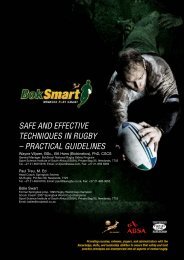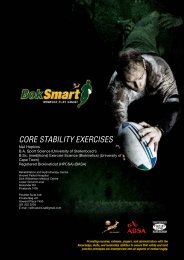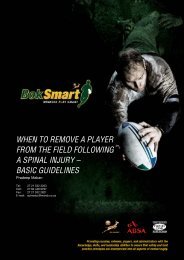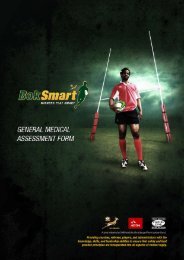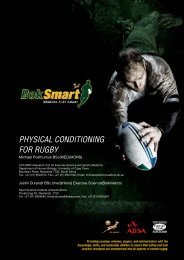FRONT PAGE HEADING PRACTICAL NUTRITION FOR ... - SA Rugby
FRONT PAGE HEADING PRACTICAL NUTRITION FOR ... - SA Rugby
FRONT PAGE HEADING PRACTICAL NUTRITION FOR ... - SA Rugby
You also want an ePaper? Increase the reach of your titles
YUMPU automatically turns print PDFs into web optimized ePapers that Google loves.
Practical Nutrition for <strong>Rugby</strong><br />
THE ROLES AND RESPONSIBILITIES OF PLAYERS<br />
• Be knowledgeable of, and comply with, all applicable anti-doping policies and rules<br />
• Be available for sample collection<br />
• Take responsibility, in the context of anti-doping, for what is ingested and used<br />
• Inform medical personnel of their obligation not to use prohibited substances and prohibited<br />
methods and take responsibility to make sure that any medical treatment received, including<br />
dietary supplements, does not violate anti-doping policies and rules.<br />
THE ROLES AND RESPONSIBILITIES OF PLAYER SUPPORT PERSONNEL<br />
• Be knowledgeable of, and comply with, all anti-doping policies and rules applicable to them or<br />
the athletes to whom they support;<br />
• Co-operate with the Doping Control Programme<br />
• Use their influence on player values and behaviour to foster anti-doping attitudes.<br />
• They need to be aware of the signs and signals that denote actual or potential steroid abuse.<br />
• Some signs to look for which may indicate doping:<br />
o Abnormally heavy bouts of training<br />
o Sudden increase in body mass and strength in an abnormally short period<br />
o The player is in remarkably good shape despite an undisciplined lifestyle and little<br />
interest in diet and correct training<br />
o Increased injury frequency, particularly in the muscular attachment points and tendons<br />
o The player shows a keen interest in health foods and nutritional supplements and has an<br />
extensive knowledge of the effect of various medicines and doping agents.<br />
SOME OF THE PROHIBITED SUBSTANCES AND THEIR SIDE-EFFECTS<br />
Stimulants<br />
Examples: Cocaine, amphetamines, ephedrine<br />
Stimulants can be found in prescription and over-the-counter medications, as well as in herbal and<br />
nutritional supplements, and enable the body to perform above its fitness level for relatively long periods.<br />
However, this can lead to injury to muscle, bone and soft tissue and put the heart under strain.<br />
Stimulants act on the central nervous system, speeding up parts of the brain and body, increasing<br />
alertness and decreasing perceived levels of fatigue. Some stimulants suppress the appetite and are<br />
used in an attempt to reduce weight.<br />
20 Copyright BokSmart © 2009








